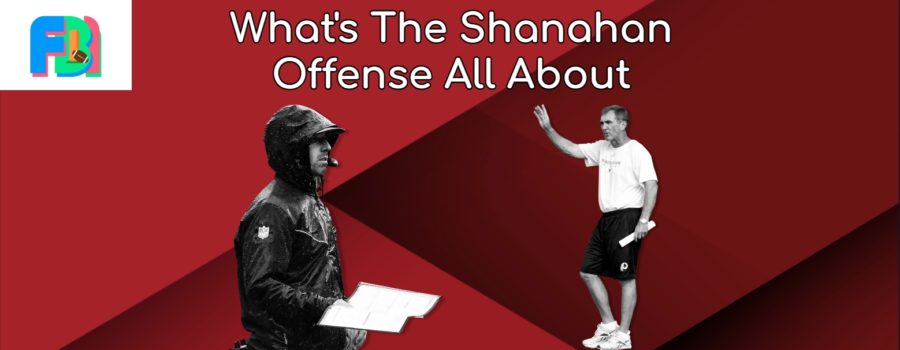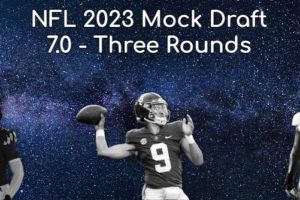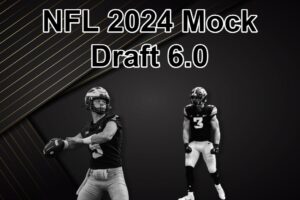Kyle Shanahan was on the hot seat just a couple of years ago, but he’s been on a mission to prove people wrong lately. Shanahan may not be a perfect coach, but I can’t help but love what he’s done to revolutionize the game of football. He has dramatically evolved offense for the better, and his style/ scheme has spread like wildfire across the NFL. You even see many college teams run the same style that Shanahan uses.
The primary questions I’ll be answering today are where this scheme came from and what it’s all about. Many fans are familiar with the Shanahan or wide zone offense but don’t honestly know what it means to run this offense or where it originated from. I will explain in detail how this scheme came about and the principles and concepts that relate to this system. Please use code TREYSCHNEIDER on Underdog Fantasy to match your deposit up to $100. Gamble responsibly and leave your feedback on Twitter @FBIntellect.
How Did The Wide-Zone Offense Originate?
As many know, Bill Walsh practically founded the west coast offense. The west coast offense back in the day was predicated on stretching the field horizontally, with both running and passing concepts. A coach named George Seifert, a Walsh disciple, was the head coach that brought in Mike Shanahan (Kyle’s father) to be the offensive play-caller for the Niners. As a play-caller in San Francisco, Walsh influenced him, but he bought into the run even further. As a matter of fact, he said he didn’t want to run anything but zone-running plays. He was also known for running the ball in the majority of plays. Mike was also practically the first coach to go primarily zone running.
It was essentially a run-heavy west coast offense but with no power or gap run schemes. Later on in his career came the evolution of play-action passing. In 2012, when Robert Griffin III was a rookie, Washington led the league in play-action yards. As you read this article, you’ll find out why play-action passing is such a crucial element of this system. Mike had tremendous success running this scheme, and it’s no wonder it’s been so influential. Mike won two Super Bowls with the Broncos and also ranked top-ten in points scored 17 times.
Kyle Shanahan was influenced by his father, of course, and runs his offense with the same fundamental principles. The dramatic difference is that Kyle has added a plethora of wrinkles to his offense. Additionally, he has prioritized the vertical passing game much more than his father. I’ll get into the specifics later on, but it’s more of a modern-style offense but with the same basic philosophy. That basic philosophy is running the living hell out of the ball, which Kyle has continued to live up to to this day. It’s my favorite offensive scheme, and there’s a good reason there are now at least a dozen teams using it.
What Has Kyle Shanahan Done To Evolve His Father’s Offense?
Most of what Kyle has done to evolve his father’s scheme has been copied by the league and has ultimately changed football for the better. In addition to his run-heavy approach, you see all sorts of creative wrinkles here and there in this offense. He also likes to build the passing game off the run game by setting up play-action shots. With Garoppolo and Purdy, you see more intermediate routes than anything else, but to its core, it’s meant to attack deep. That isn’t something we necessarily saw from Mike, but Kyle is one of the very best at drawing up play-action shot plays.
An underrated element of Kyle is that he knows how to call plays accordingly to his player’s strengths. You don’t see him try and force Garoppolo to throw deep. Instead, we see his offense revert to the classic west coast passing philosophy when he’s stuck with a weak arm QB. He had the foresight to use Deebo Samuel as a running back, which paid off. Deebo also thrives in running hitch routes, and Shanahan will prioritize that in the passing game. It’s one of the many reasons Shanahan, in particular, has had so much success.
In addition to the wide-zone running, we see plenty of down-blocking and pulling Linemen. Kyle has relied on power, and the gap scheme runs much more than his father. That is a classic wrinkle thrown into his offense and makes a big difference, as some teams would mainly play the zone run well. It makes for a highly challenging offense when multiple running schemes get thrown at you. Roughly 35% are gap-running schemes, while approximately 50% are zone-running schemes. Implementing power was highly necessary and made for one of the most unpredictable offenses to plan for.
Moreover, Kyle always has a handful of creative play calls hidden up his sleeve. One of the significant evolutions to this offense is the element of jet sweeps and reverse outside-zone running plays. You’ll also see cleverly designed Tight End leaks. His list of creative play designs with Kyle Juszczyk is remarkable.
The use of motion has been a dramatic game-changer for Shanahan. He is one of the very first play-callers to start heavily using motion. This pre-snap motion helps disguise the play while also helping identify whether it’s man coverage. One form of motion is called jet motion. This motion gives the QB the option for a handoff or a toss pass. Then there’s fly motion, where the player motions past the QB right before the snap. That makes the Linebacker hesitate before the handoff. Finally, there’s glide motion, where the Receiver simply glides from the slot to out wide.
This concept has also branched off into pick plays. That is where one Receiver will pick off the DB covering the second Receiver, and the second Receiver will have an accessible avenue to get open. Another underrated element of motion is that it makes pressing the Receiver challenging. It can also eliminate a double team task on a Receiver if appropriately used. Kyle’s team has always been in the top ten for pre-snap motion usage, and it’s for a particular reason.
As mentioned in “Who Is The Best Offensive Play-Caller in Football?” Kyle likes to take advantage of the numbers game in the run and passing games. The numbers advantage is basically where there are fewer defenders in an area than are blockers. Then there are times when there are more Receivers on the side where there are fewer DBs. Shanahan is aware of this and will adjust the play call accordingly. That is one of the many outstanding aspects of his coaching ability.
The Wide Zone Running Scheme:
The wide zone running scheme is all about running outside with zone-blocking principles. The idea is to stretch the field horizontally while leaving the middle of the field open off of play action. Brett Kollmann made an excellent video about the wide-zone offense, and I recommend it for an even more detailed breakdown of the run game. We Primarily see stretch runs, classic outside zone, toss cracks, and a moderate mixture of power and gap runs.
On the defensive line, there is something called the bubble. That is where there is the most depth between D-Linemen. Its primary goal of Shanahan is to attack the bubble with the blockers. To attack the bubble, the O-Linemen in that area will do what’s called a combo block. As Brett described, a combo isn’t necessarily a double team. It’s where they will help cut off the D-Linemen and quickly get upfield to block a Linebacker. Shanahan has them adjust who combo blocks depending on the personnel. There’s then the reach block, which is where they attempt to gain outside leverage rather than blocking straight up. The reach block is a necessity in the wide zone offense.
Reach blocking and getting to the second level takes highly athletic O-Linemen. There’s a reason you see these wide-zone teams draft fast and agile O-Linemen. Specifically, the Center and the two Tackles need to be mobile. The guards typically don’t have to block as much in space, but the Tackles and Centers do, especially on screens. In addition to the reach blocking and combo blocking, there’s also a fair share of pulls in this running offense.
One play where Kyle’s innovation shined was when he had Trent Williams motion to the right on an outside run. With the momentum he generated pre-snap, he came in like a wrecking ball and bulldozed multiple defenders. Shanahan has had exceptional O-Linemen for years, and it will be fascinating to see how he fares with an inexperienced group.
With Trey Lance, Shanahan was able to call various designed QB runs. The most basic QB run is the zone read. Branching off of that is the inverted veer. The inverted veer isn’t commonly seen but is heavily prominent in Baltimore. It’s a read option, but the QB’s path is inside, while the back’s path is outside. In addition to those runs are draw plays and power runs. Unfortunately, we likely won’t see Lance play again with the Niners but look for him to get paired in another wide zone offense.
The running back has four possible zones to choose from on an outside-zone run. The first read is outside the Tight End, and it works all the way down to a cutback being the fourth read. They have four lanes to attack and pick whichever lane opens up first. That allows it so only one O-Linemen has to win their matchup for the play to work. In addition to the wide zone and gap running concepts, Shahanan also uses inside zone, split zone, and weak-side zone. With McCaffrey, we got to see the Shanahan running offense at its best, and it’ll be exciting to see it again.
The Shanahan Passing Attack:
As I already mentioned, the passing offense is built from play-action. The central premise is to get the linebackers to bite on outside play-action, leaving the middle of the field vulnerable to attack. The fundamental principle of this passing offense is rhythm and timing. We see many 3-step and 5-step drops in this offense in addition to the shotgun formations. 3-step and 5-step drops allow for better timing in the offense and are even referred to as rhythm drops.
Shanahan still uses many basic fundamental plays used in his father’s offense. However, his passing game now involves more modern concepts and looks more unique. Because the play-action game pulls the Linebackers away from the middle of the field, Kyle loves to attack that area. With Garoppolo, the Niners ranked top ten in intermediate passing attempts three years in a row. In this offense, there’s a ton of 12 and 21 personnel. As many know, he makes excellent use of Fullback Juszczyk. Below are some examples of his passing concepts out of 21 personnel.

As you can see, Shanahan primarily targets the intermediate range of the field while always having an outlet. He sets up an alert to take advantage of the entire field. An alert is a common aspect of the west coast passing offense and is prevalent in the Shanahan offense. It becomes the number one read if it’s a particular coverage. For example, if it’s bump and run, the alert route which is a vertical route becomes the primary read. That is one of the many reasons this is such a QB-friendly scheme.
Crossers of all sorts are heavily prevalent in this scheme. Crossers are a perfect pairing with play-action as the Linebacker is stressed to play the run but is challenged to get enough depth to defend the route. You’ll see deep crossers, short crossers, and even some deep posts. With guys like Deebo and Kittle, the crosser can be a lethal threat in this offense. Another staple of the Shanahan passing attack is bootlegs. Bootlegs work perfectly in this scheme, as outside runs are heavily prevalent. A PA boot is a play-action stretch run where the QB rolls to the opposite side, away from where the back was headed. When the defense is expecting outside zone, they get a hit with a play-action boot going the opposite direction, and the Linebackers aren’t in a proper position to cover the Receivers.
One of the most significant differences between his father’s offense and his is his usage of shotgun formation. We specifically saw a ton of shotgun usage in his days with Atlanta, where he had the personnel to run 11 personnel. Since joining the Niners, he’s bought into 12 and 21 personnel much more due to his change in personnel. There’s still a decent amount of Shotgun in this current offense, but it’s typically in two-minute drills.
An example of his genius is how he will set up a particular play. If he just had a screen go for a big play, he’ll call a run play with a screen pump fake soon after. That would obviously increase the chances of the Linebackers falling for the pump fake.
One creative trick he had up his sleeve was a screen pass to McCaffrey, which became a pass from McCafrey to Aiyuk that led to a big TD. It was a brilliant play that drew the Corners up to defend the screen, as they never saw the deep pass coming. The list of genius passing and running concepts he’s designed can go for days, but these are two terrific examples.
Moreover, Shanahan is one of the best screen callers in recent memory of the NFL. Right after heavily running the ball, he’ll call a screen when the defense calls up a run blitz. The timing of his screens is what dramatically alters the result. On top of that, he can design beautiful screenplays. He uses motion to manipulate defenders and then uses play action to throw off the defense further. Kyle often ranks in the top ten in screen attempts, and it’s a major staple in this offense.
Final Conclusion:
I hope I convinced you just how brilliant Shanahan is and you understand why this scheme works. He is genuinely one of the most fascinating figures in sports. While an elite offensive mind, Shanahan is also an incredible head coach. If you listen to his interviews, you’ll see he’s very down-to-earth and likable. It’s no wonder the players like him so much and play their hardest under him.
It may seem like Kyle’s avenue to the league was a simple and easy one. However, he had to work as a quality control coach all the way up to the head coaching spot. He spent nine years as an offensive coordinator before becoming a head coach. His path to the league wasn’t an easy one. What he’s done to change the game of offense entirely is unparalleled. I am thankful I get to witness this level of brilliance in real-time. It’s about time fans, and the media start to appreciate what he’s accomplished and how he improved football.







Recent Comments